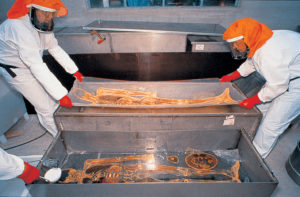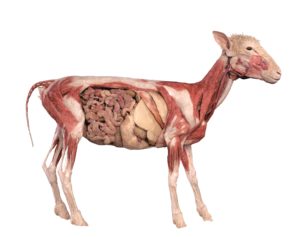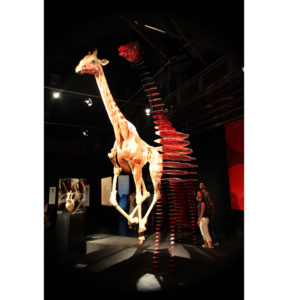The foundation of modern biology is that life evolves over time through natural selection. Evidence confirming this scientific principle is on glorious display at Body Worlds: Animal Inside Out, an exhibit at the Science Museum of Virginia through September 3. My wife and I took my 8-year-old daughter to check it out this past weekend.
The exhibit features animal specimens preserved through plastination, a process that replaces natural fluids in a body with reactive plastics, so the animals look like statues. In some of the exhibits, these plastinates are cross-sectioned so that  one can see their internal parts. The exhibit is divided into six areas featuring the different biological systems (muscular, digestive, reproductive, etc.). You get to see things like the inside of a giant squid, the blood vessels of a rabbit, and a cat’s brain with its eyes still attached. The exhibit emphasizes how similar these animals can be. Seeing how the wing bones of a bat look just like the hands and paws of other mammal’s hands/paws really drives home that these animals share a common ancestor.
one can see their internal parts. The exhibit is divided into six areas featuring the different biological systems (muscular, digestive, reproductive, etc.). You get to see things like the inside of a giant squid, the blood vessels of a rabbit, and a cat’s brain with its eyes still attached. The exhibit emphasizes how similar these animals can be. Seeing how the wing bones of a bat look just like the hands and paws of other mammal’s hands/paws really drives home that these animals share a common ancestor.
 All of the specimens are ethically sourced and no animal was harmed for the purpose of the exhibit. The animals came from places like veterinary schools and zoos, and the human specimens came from a voluntary body donation program. I’d suggest reading the material about the exhibit’s origins before your trip on the Science Museum of Virginia’s website. We went in not knowing much about what we were about to see, and it took us an exhibit room or two before we realized we were looking at actual animals and not reproductions.
All of the specimens are ethically sourced and no animal was harmed for the purpose of the exhibit. The animals came from places like veterinary schools and zoos, and the human specimens came from a voluntary body donation program. I’d suggest reading the material about the exhibit’s origins before your trip on the Science Museum of Virginia’s website. We went in not knowing much about what we were about to see, and it took us an exhibit room or two before we realized we were looking at actual animals and not reproductions.
A highlight for my daughter was seeing the exhibit she called “slices of giraffe,” where cross-sections of a giraffe’s neck ascend toward the ceiling. She greeted this and most pieces of the exhibit with an audible “ewwww,” but it was clearly the “ewwww”  of leaning in closer to see and learn more, not one of reservation or revulsion.
of leaning in closer to see and learn more, not one of reservation or revulsion.
Speaking of the giraffe, I was also excited to see Earth’s tallest mammal. You see, a remarkable example of how a species might evolve over time is a giraffe’s laryngeal nerve. This nerve branches off from a giraffe’s brain, travels all the way down its neck, around some other bits, then all the way back up the giraffe’s neck to connect to its larynx. This makes no sense if you were an engineer designing a giraffe robot, but is an amazing artifact of how the ancestors of a giraffe evolved over time. I’d never been this close to a giraffe before, and it really hit home just how far that nerve has to go.
Featuring more than one hundred plastinates, from complete bodies to tiny specimens, Animal Inside Out includes the rarely seen giant squid, a bull (with a heart five times the size of ours), and a reindeer.
In addition, the Science Museum of Virginia has other activities meant to compliment the Body Worlds exhibit. Immediately after Animal Inside Out, you can explore Fantastic Fauna, a museum-curated collection dedicated to the behaviors and characteristics of animal. On our trip Saturday, we went to a screening of Amazon Adventure at The Dome, Virginia’s largest indoor theatre screen. The movie is about British scientist Henry Bates who travels to the Amazon River valley to collect specimens of species previously unknown to western scientists. He eventually discovers a continuum of butterfly wing coloring variation over time that is some of the first evidence confirming the Theory of Evolution.
The visuals of the Amazonian animals were pretty stunning on the screen (especially the caterpillar that looks like a snake). My main wish is that the film had spent more of its 45-minute run time showing more nature and less of the human actors. But, I did learn about Bates and his role in scientific history, so I don’t consider it time misspent. This was my 8-year-old’s first movie at giant screen format theatre, and I’m glad she could see such a safe movie as her first experience.
Combined with the permanent exhibits at the Science Museum of Virginia, the Body Worlds: Animal Inside Out exhibit, and accompanying activities are a fine way to spend a Saturday afternoon with your family and an excellent introduction to evolutionary biology.
__________________________________________________________________
 Body Worlds: Animal Inside Out will be on display in the Dewey Gottwald Center through September 3. The Science Museum of Virginia is the only venue in the Southeast currently scheduled to host the show. Tickets for this touring exhibition are $22.50, which also includes admission to permanent exhibits. From May 11 through August 31, during extended hours on Fridays from 5 p.m. to 8 p.m., non-member guests can see Animal Inside Out for the reduced exhibition-only price of $10. All other museum exhibits will be closed at this time.
Body Worlds: Animal Inside Out will be on display in the Dewey Gottwald Center through September 3. The Science Museum of Virginia is the only venue in the Southeast currently scheduled to host the show. Tickets for this touring exhibition are $22.50, which also includes admission to permanent exhibits. From May 11 through August 31, during extended hours on Fridays from 5 p.m. to 8 p.m., non-member guests can see Animal Inside Out for the reduced exhibition-only price of $10. All other museum exhibits will be closed at this time.
Members of the Science Museum of Virginia can explore Animal Inside Out for $5.







